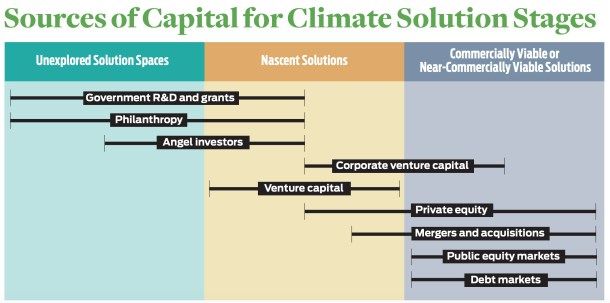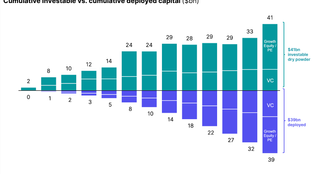
🌎 A weak $11.3bn start to 2024
Poor performance this half as investment falls to 2020 levels, but some strong plays.
Many climate solutions include tangible, “hard” technologies to limit or reduce carbon emissions. The products can range from meat substitutes to carbon sequestration devices. These technologies often bear special development risks that deter private investment.
Many climate solutions include tangible, “hard” technologies to limit or reduce carbon emissions. The products can range from meat substitutes to carbon sequestration devices. These technologies often bear special development risks that deter private investment.
Some funders seek to help companies overcome this financing obstacle. Last week, for example, Prime Impact Fund, an initiative of the nonprofit Prime Coalition, announced its final close with $50 million to “address critical funding gaps for climate solutions” and invest in “high-risk, high-reward” climate technologies.
To understand how Prime Coalition seeks to address this funding gap, we spoke to two of its staff: Director of Partnerships, Maggie Cutts, and Principal of Prime Impact Fund, Amy Duffuor.
Cutts said that the most transformational climate technology solutions tend to rely on hard tech, for which it is “inherently harder to attract capital.” The reasons for these fundraising difficulties, she explained, include that hard tech typically “isn’t consumer facing, has long timelines to proof points, and is more capital-intensive.”
According to Cutts, Prime Impact Fund uses “catalytic capital” to support these types of technologies. The MacArthur Foundation, the Fund’s largest investor, defines catalytic capital as “debt, equity, guarantees, and other investments that accept disproportionate risk and/or concessionary returns relative to a conventional investment to generate positive impact and to enable third-party investment that otherwise would not be possible.”
Duffuor calls it “impact-first capital.” She said, “We don’t view investments as concessionary on return. Rather, our inherently patient and flexible capital allows us to support high risk, high reward ventures.”
Catalytic capital enables climate tech companies to turn unexplored ideas into proven solutions, which are likelier to attract conventional venture capital (VC) funding.
Like other products, emerging climate tech solutions span an “innovation continuum.” This phrase, as presented in a 2018 article in Stanford Social Innovation Review, encompasses three stages of product development:
Each stage is likely to appeal to different sources of capital:

The sources of capital best suited for each stage of development (Stanford Social Innovation Review)
Catalytic capital, like that in Prime Impact Fund, focuses on the same stage as angel investors and philanthropies to make companies more attractive for subsequent conventional venture finance.
These early stage funders are often more risk-tolerant and patient than most VC investors. They are willing to absorb large perceived risks that VCs often avoid, such as substantial upfront capital requirements, long and uncertain product development periods, and extended timelines for investment returns. For example, The David and Lucile Packard Foundation, another investor in Prime Impact Fund, funds “ideas that are not receiving adequate investment but have the potential to yield significant reductions in carbon emissions.”
By contrast, VC firms typically seek companies with promising – less risky – products that will offer their investments a foreseeable exit opportunity, such as an IPO or stock sale. Early stage VCs provide seed capital, while other VCs often invest to scale a company that already has market traction or a demonstrated proof-of-concept. In either case, their ultimate goal is generally to maximize returns within a specific time period.
As profit-maximizers, VCs in the climate space tend to target solutions that are more proven and can scale within a shorter time frame. Philanthropies, on the other hand, are driven by social and environmental impact. Therefore, their catalytic capital is a better fit for riskier climate solutions with longer development timelines. Prime Impact Fund seeks to fill the capital gap for new technologies with catalytic capital to build companies that will be attractive to conventional investors down the line.
Prime Impact Fund is “looking for solutions that could achieve transformative climate impact,” according to Duffuor.
Cutts and Duffuor described three criteria they use to evaluate an investment:
[Note: Companies fitting this profile can apply for Prime Impact Fund financing here.]
One new company in Prime’s portfolio, Clean Crop Technologies, applies High Voltage Atmospheric Cold Plasma (HVACP) technology to reduce food waste and crop loss in developed and emerging markets. Each year, toxins, pathogens, and pests lead to approximately 500 million tons of food waste between the farm and consumer, in addition to more than 400,000 deaths.
Clean Crop’s “hard tech” solution aims to mitigate these large-scale emissions and negative human health impacts. Duffuor said, “We have conviction that Clean Crop can drastically reduce emissions in one of the largest greenhouse gas wedges and build a large, self-sustaining business.”
Greater availability of catalytic capital like that from Prime Impact Fund can help propel riskier climate tech by removing traditional financing barriers for hard tech companies.
In February, Jeff Bezos announced the Bezos Earth Fund, a $10 billion environmentally-focused philanthropic initiative. The fund is expected to start giving grants this summer. Although the details of how this money will be spent have not been announced, Cutts views this initiative, as well as other public commitments by large asset owners, as an important signal to the world that the size and urgency of climate change is massive and requires major shifts in the way capital is currently allocated.
Funding fresh innovation in gigaton-scale climate fields like carbon capture, sustainable agriculture, and industrial process heat will launch new pillars of the low-carbon economy, which is needed to fight the urgent, existential threat of climate change.
Interested in more content like this? Subscribe to our weekly newsletter on Climate Tech below!

Poor performance this half as investment falls to 2020 levels, but some strong plays.

$82bn of new capital for climate tech in the past 6 months

A new interactive Climate Capital Stack Map